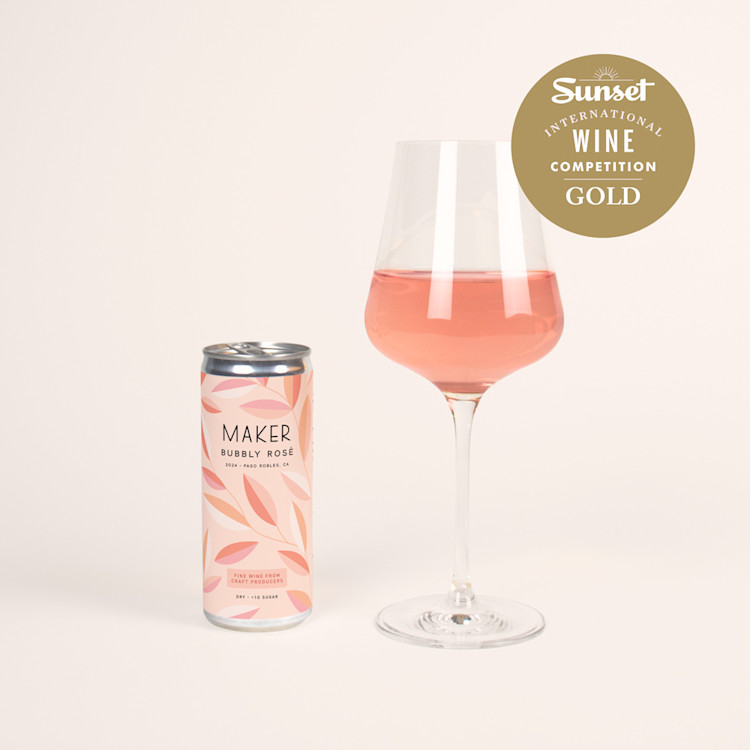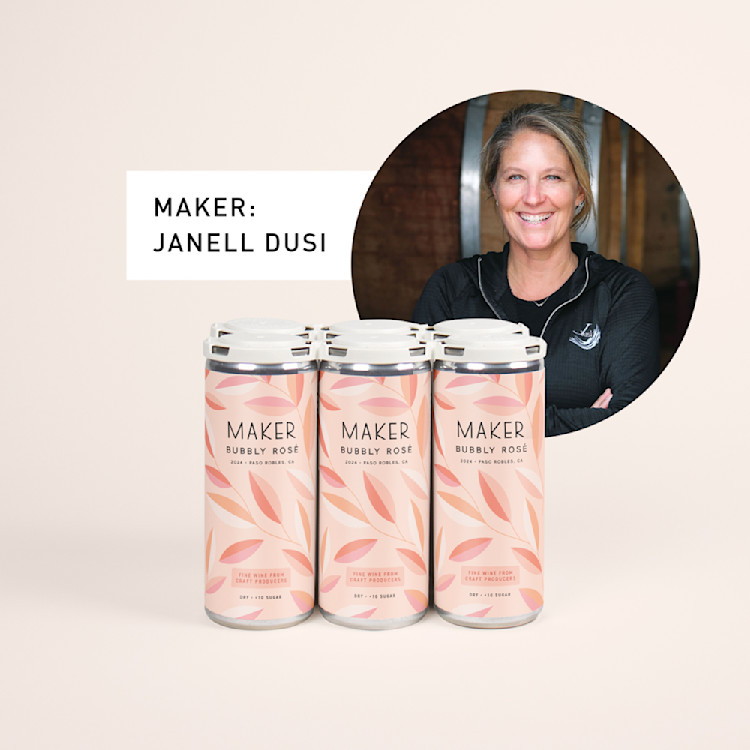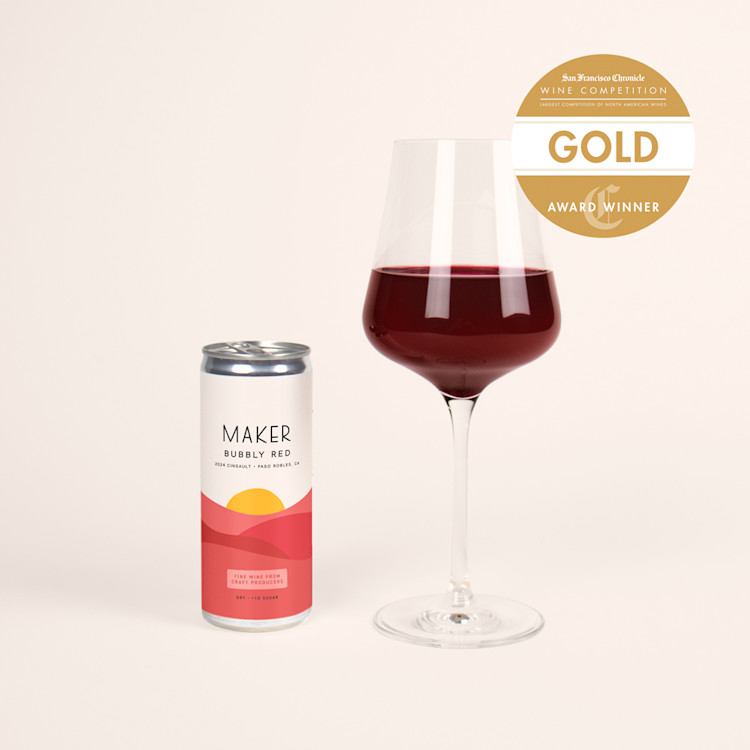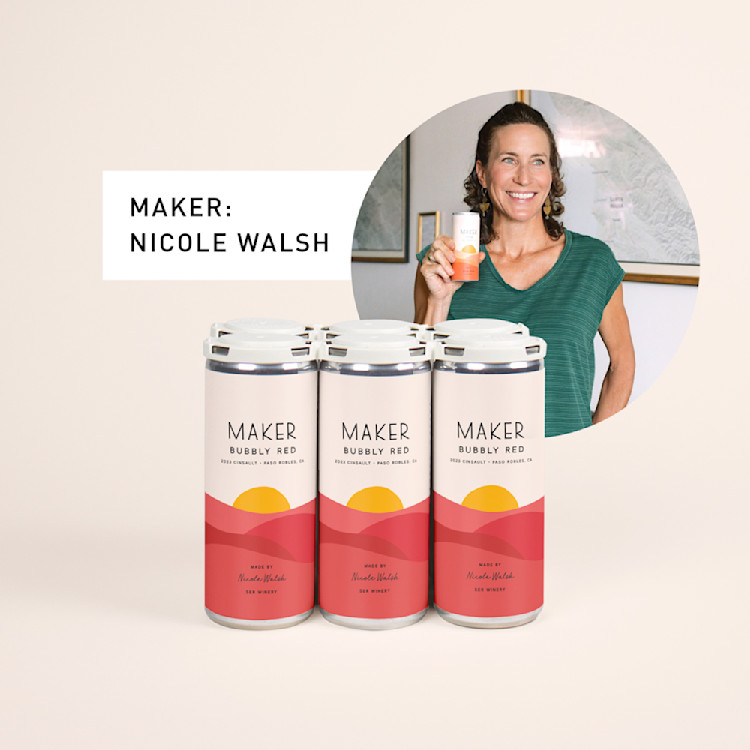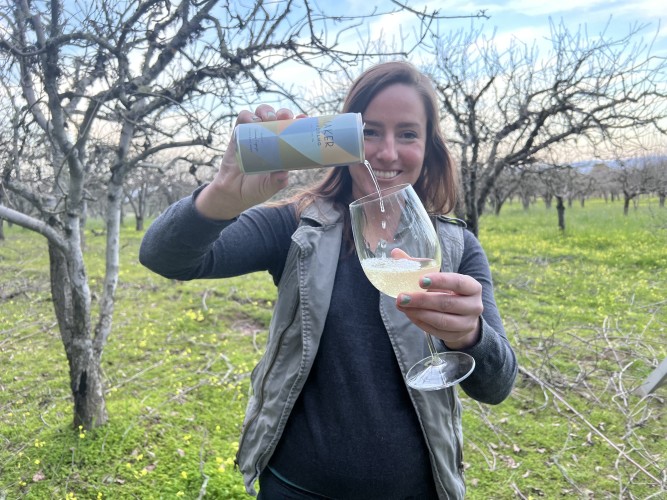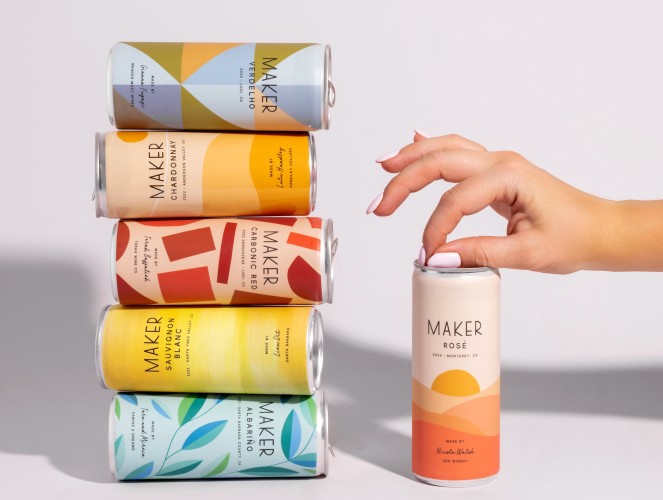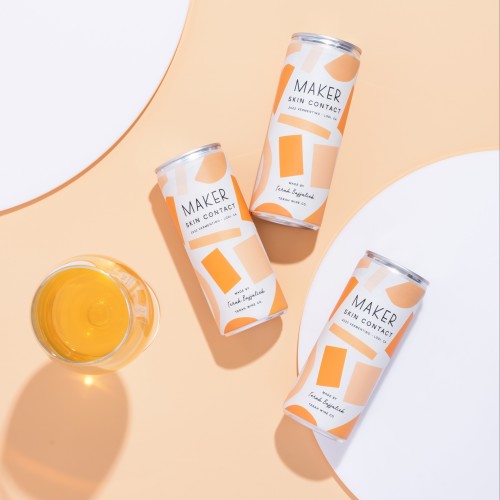Wine School
Wine 101: What Is Sparkling Wine? A No-Fluff Guide to Bubbles, Brut, and Beyond
Learn what sparkling wine is, how it's made, and how it differs from Champagne—plus brut, pét-nat, sparkling rosé, sparkling red wine, and more.

By Maker Wine
July 14, 2025
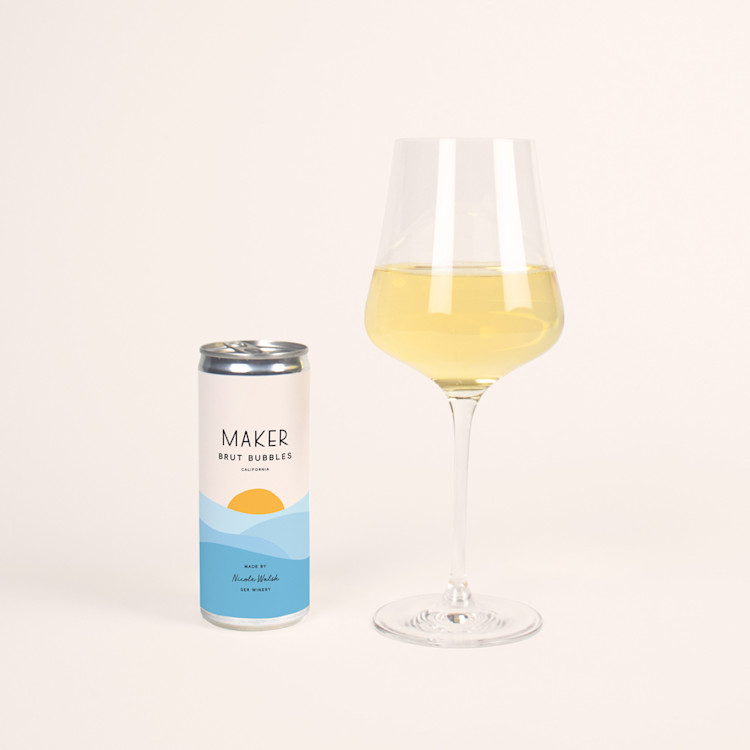
Sparkling wine: it’s festive, fizzy, and somehow makes any moment feel more intentional. But beyond the clink of flutes and celebratory clichés lies a surprisingly complex—and often misunderstood—category of wine.
This post is your straight-up guide to what sparkling wine actually is, how it’s made, how it differs from Champagne, and why not all bubbly tastes (or costs) the same. Whether you’re deep in pét-nat land or just googled “what is sparkling wine,” you’re in the right place.
Let’s dive into the bubbles.
What Makes Sparkling Wine Sparkle?
At its simplest, sparkling wine is wine with dissolved carbon dioxide (CO₂)—that’s what creates the bubbles.
Sparkling wine gets its fizz from carbon dioxide, which can be introduced in a few different ways—some dating back centuries, others more modern. The most traditional (and common!) approach is through a second fermentation, where yeast consumes sugar and produces both alcohol and carbon dioxide. When this fermentation happens in a sealed environment, the CO₂ stays dissolved in the wine, creating natural bubbles.
There are several ways winemakers can achieve this—ranging from centuries-old techniques to newer, practical innovations—and the method they choose shapes the wine’s taste, texture, longevity, and how it's best enjoyed.
Types of Sparkling Wine: How It’s Made
Traditional Method (Methode Traditionelle, aka Méthode Champenoise)
Used for: Champagne, Cava, Crémant, Franciacorta, Sekt (traditional method), Italian Metodo Classico wines
Second fermentation happens inside the bottle after the winemaker creates the base wine blend, or "cuvee".
Wine ages on the lees (dead yeast) for complexity between 15 months and 5 years—think brioche, toast, creaminess, nuttiness.
Requires riddling (rotating bottles) and disgorgement (removing sediment).
Typically high-pressure, creating persistent, fine bubbles and a creamy mousse.
Time- and labor-intensive = higher cost, rounder, complex textures.
Tank Method (aka Charmat Method)
Used for: Prosecco, Lambrusco, many sparkling rosés
Second fermentation happens in a pressurized tank, not individual bottles.
Faster and less expensive.
Retains fruity, floral aromatics—think white peach, pear, melon.
Typically medium-pressure (2.5–4 atmospheres), resulting in lighter, more playful bubbles.
Usually released young and meant to be drunk fresh rather than aged.
Ancestral Method (aka Pét-Nat, aka Methode Ancestrale)
Used for: Pétillant naturel wines globally
The OG method—wine is bottled before fermentation is complete.
Natural bubbles, no dosage (sugar addition), often unfiltered.
Cloudy, rustic, sometimes funky, often textured—like raw cider meets Champagne.
Typically low-pressure, resulting in a softer, gentler fizz compared to traditional-method sparklers.
Carbonation
Used for: High-quality canned wines, bright, casual sparklers, some New World styles
CO₂ is added directly to still wine after the winemaker creates their blend or base wine
Helps preserve freshness and bright, juicy taste profiles, especially in aromatic or youthful styles.
Useful when a winemaker wants bubbles without altering alcohol levels or introducing sweetness through second fermentation.
Typically results in slightly larger, less persistent bubbles than fermentation-based methods.
Commonly used for canned formats, where stability, freshness, and drink-now appeal are key.
Is Sparkling Wine the Same as Champagne?
Not quite. All Champagne is sparkling wine, but not all sparkling wine is Champagne.
“Champagne” is a legally protected term for sparkling wine made in the Champagne region of France, using the traditional method and specific grapes (mainly Chardonnay, Pinot Noir, and Pinot Meunier).
Other sparkling wines—like Prosecco, Cava, pét-nat, or a California Brut—may taste similar, but they follow different rules, grapes, or methods.
Here’s a quick comparison:
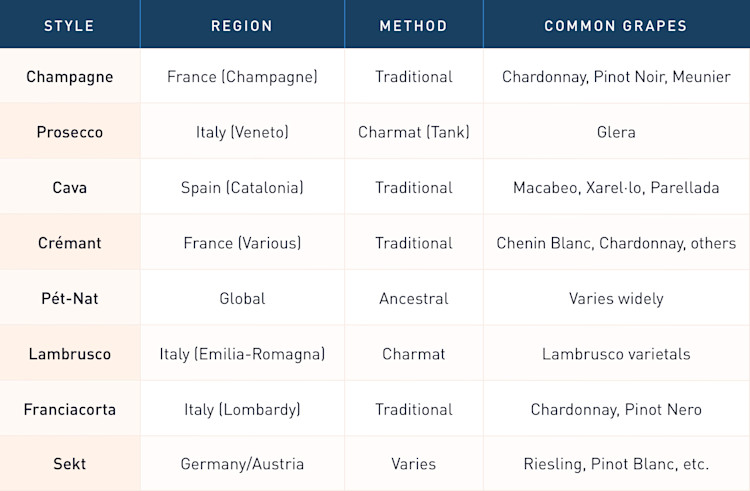
Is Sparkling Wine Sweet or Dry?
It can be sweet—but most isn’t. Here's how it works:
In many traditional-method wines, sweetness is adjusted through dosage—a small addition of sugar and wine after disgorgement. The label usually indicates sweetness level:
Brut Nature / Extra Brut – bone dry
Brut – dry (most common)
Extra Dry – slightly sweet (yep, confusing)
Demi-Sec / Doux – noticeably sweet
Some styles—like Moscato d’Asti or sweet Lambrusco—get their sweetness from arrested fermentation (a technique where fermentation is stopped early to preserve natural grape sugars), not dosage.
Most sparkling wines you’ll find at a wine shop are dry—unless labeled otherwise. That said, styles like Prosecco and Moscato often contain added sugar, which can sneak up on you (and your hangover). If you're unsure, check the label or ask your wine shop.
💡Note: although you may experience a wine feeling “drying” in your mouth, the term “dry” in wine simply means that a wine does not have any sweetness or sugar! More about dry wines here.
What Is Sparkling Rosé Wine?
Sparkling rosé wine is exactly what it sounds like: bubbly, pink, and perfect for warm days, brunches, and beyond. It's usually made the same way as a rosé wine, by allowing short skin contact with red grapes (like Pinot Noir or Grenache), or for traditional sparkling rosés like pink Champagne, by blending a small amount of red wine into a white base. Most are dry or off-dry, with bright fruit flavors and crisp acidity—but the fresh berry notes and floral aromatics can give the impression of sweetness even when there’s very little residual sugar.
Like traditional sparkling wine, rosé bubbles can be made in a variety of methods. You’ll find sparkling rosé from France (Crémant de Loire Rosé or Champagne Rosé), Italy (Brachetto, sparkling Lambrusco Rosato), Spain (Rosado Cava), and more. In most cases, the label will indicate if it’s a Brut rosé (dry), Extra Dry (a bit sweeter), or Demi-Sec (noticeably sweet). If in doubt, ask your wine shop or look for Brut.
Want a deeper dive into pink wine? Check out our rosé wine guide.
Maker's Bubbly Rosé is a completely bone dry sparkling rosé, with zero sugar. Made with Grenache, Merlot, and Zinfandel grapes, it's luscious and fruity without tasting sweet at all.
Shop Sparkling Rosé
Bubbly Rosé Wine
J Dusi, Paso Robles, CA
Juicy watermelon, ripe summer strawberry, and light bubbles — an expressive, sunshine-y sparkling rosé.
What about sparkling red wines?
Yes! There’s also sparkling red wine, like Lambrusco (or hello, Bubbly Red), which ranges from dry to off-dry, with vibrant red fruit, floral notes, and refreshing acidity. Lambrusco often has a poor reputation, because the market was flooded with cheap, sickly sweet wines in the 1980s, but since then, tastes in sparkling red wine have shifted, and most available are light, dry, and easy to pair with just about anything.
Our Bubbly Red is a sparkling red wine made from 100% Cinsault grapes grown organically in Monterey, California, and whole-cluster fermented. It’s bright and floral, chillable, and surprisingly dry—with notes of tangy fresh red fruit and rose petals. Unlike the syrupy-sweet red fizz you might be picturing, this one’s delicate, bright, and a little bit wild—in the best way.
Shop Bubbly Red
Bubbly Red
Ser Winery, Central Coast, CA
Bright strawberry, cherry, and rose petal – a sultry red bubbly that loves a pepperoni pizza.
A Maker Take on Brut: Brut Bubbles
Maker’s Brut Bubbles is our take on a classic dry, French-inspired sparkling wine—but made in California and crafted for cans. It’s crisp and aromatic, with notes of yellow apple, grapefruit, and tropical fruit.
Made in collaboration with winemaker Nicole Walsh, this wine is full of coastal freshness and nuance, and stays true to the dry, no-sugar profile that defines our sparkling line.
The result is a vibrant, celebratory sparkler with zero sugar and no fluff—just bright bubbles and a coastal state of mind.
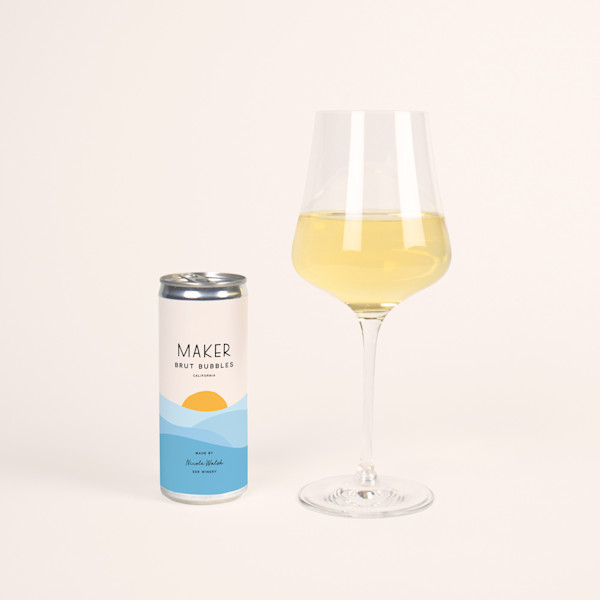
Shop Brut Bubbles
Dry sparkling white wine with notes of white flowers and tropical fruits.
So… What Is Carbonated Wine?
The term “carbonated wine” can sound industrial, but it simply refers to adding CO₂ to still wine rather than creating bubbles through fermentation. It’s one of several great methods for making sparkling wine, and like any technique, choosing it depends on the winemaker's intention.
At Maker, we choose this method because it offers excellent consistency and stability in cans—an essential quality for sparkling wine in single-serve formats. It also supports the work of our winemakers who focus on dry, lower-alcohol wines with zero sugar. Carbonation helps preserve the integrity of these wines: their bright acidity, fresh fruit character, and youthful aromatics. Done thoughtfully, it’s a tool that allows us to make wines that are honest to the fruit and vineyard without the additional alcohol or sweetness that traditional second fermentation can sometimes introduce.
The key is starting with quality grapes and a clear stylistic goal—carbonation simply provides another way to serve that vision.
The Takeaway
Sparkling wine isn’t just Champagne—or Prosecco, or what you drink on New Year’s Eve. It’s a wild, wonderfully technical category that spans ancient methods, modern tools, and a whole lot of nuance. Some bottles are built for decades of aging. Others, like ours, are meant for the moment—crisp, clean, and best enjoyed with friends (or at 10,000 feet on your next United Airlines flight).
Sparkling wine is infinitely pairable, and great all year round: we love our Bubbly Rosé with brunch, tacos al pastor, or a cheese plate. Brut Bubbles goes with just about anything but we have a soft spot for pairing it with ceviche—or just sipping in the sunshine. Bubbly Red is phenomenal with a pepperoni pizza, Char Siu, or mediterranean food.
These styles are fun, food-friendly, and often underrated—and a little unexpected in the best way.
Whether it’s hand-riddled in a cave or carbonated in a tank, the best sparkling wine doesn’t come from a formula—it comes from intention.
So forget the rules. Trust your taste. And find the fizz that fits your vibe.
Sparkling Wine FAQs
Q: What is sparkling wine?
A: Sparkling wine is wine with bubbles, caused by dissolved carbon dioxide—introduced either by fermentation or carbonation.
Q: Is sparkling wine the same as Champagne?
A. No. Champagne is a type of sparkling wine made in the Champagne region of France using specific grapes and traditional methods.
Q: How does pét-nat compare to Champagne?
A: Pét-nat is naturally fizzy and rustic, while Champagne is aged and refined through the riddling, disgorgement, and dosage process—both sparkling wines, but very different in style and technique. Both are textured and complex from aging on the lees, but sweetness, fizziness, and flavors depend on the grapes and style.
Q: What is brut sparkling wine?
A: Brut means “dry” in French—it’s the most common sparkling wine style, with little or no residual sugar.
Q:Is sparkling wine always sweet?
A: No. Most sparkling wines are dry. Sweetness varies depending on the style and labeling terms like Brut, Extra Dry, or Demi-Sec.
Q: What’s the difference between brut and extra dry?
A: Brut is actually drier than Extra Dry. Extra Dry has slightly more residual sugar.
Q: What about non-alcoholic sparkling wine?
A: Non-alcoholic sparkling wine is made using similar methods but with alcohol removed, usually through a process of de-alcoholization after the wine is finished. The category is pretty new and there aren't yet a lot of reliably excellent options here, but we've got our ears open for good quality contenders!
Q: How long does sparkling wine last once opened?
A: Once opened, it’s best within 1–2 days. Unopened bottles or cans depend on the style, but most are best enjoyed fresh unless aged intentionally. A great benefit of cans is that you never need to worry about finishing an entire bottle before it goes bad! Every can is 1/3 of a bottle, or a hefty single glass.
